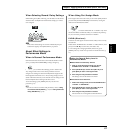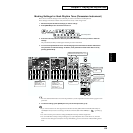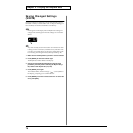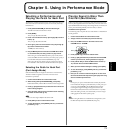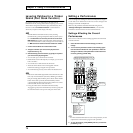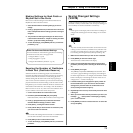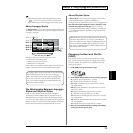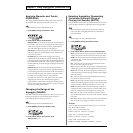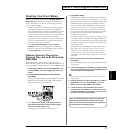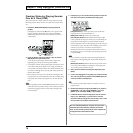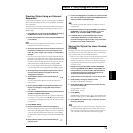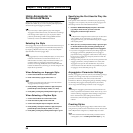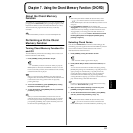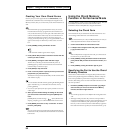
75
Chapter 6. Using Arpeggiator (ARPEGGIATOR)
Chapter 6
When the System function FOOT SW (Foot Switch) is set to
“ ”, you can also use the foot switch connected to the
FOOT SWITCH jack to switch Arpeggio Style numbers (p. 91).
About Arpeggio Styles
An Arpeggio Style is a series of data for basic arpeggio patterns and
chord styles recorded in the form of a grid consisting of a maximum
of 32 steps x 16 pitches.
fig.06-04
Each grid contains one of the following kinds of data.
• ON: Note On (with Velocity data)
• TIE: Tie (hold of the previous note)
• REST: Rest (no sound played)
The keys that are pressed along with the sequence in which they are
pressed is referenced to the “lowest-pitched key during input.”
The Relationship Between Arpeggio
Styles and Rhythm Styles
When you select a Rhythm Set in Patch mode, Arpeggiator
automatically switches to Rhythm Style performances or input.
When a Rhythm Set is assigned to Part 4/R in Performance mode,
you can have the rhythm pattern play together with the arpeggio. In
addition, if a Style is created when Part 4/R is selected with the Part
buttons, then automatically it is a Rhythm Style that is created.
About Rhythm Styles
A Rhythm Style is data recording the Arpeggiator action (which
creates the Rhythm Style) as applied to a Rhythm Set.
Although the data is organized the same way it is in Arpeggio Styles,
they differ from regular arpeggios in that it is always the notes
specified during input that are played. They do not change
according to the keys pressed during a performance, and they play
in a set, fixed rhythm pattern, regardless of the pitches of the keys
that are pressed.
Changing the Beat and Shuffle
(GRID)
This sets the particular note division and resolution in a “single
grid” used in creating the arpeggio in an Arpeggio Style, and how
much of a “shuffle” syncopation is to be to applied (none/weak/
strong) to it (grid type).
1. Press [GRID], causing the indicator to light.
fig.06-05
2. Press [VALUE ▼/▲] to select one of the following grid types.
04_: Quarter note (one grid section = one beat)
08_: Eighth note (two grid sections = one beat)
08L: Eighth note shuffle Light (two grid sections = one beat,
with a light shuffle)
08H: Eighth note shuffle Heavy (two grid sections = one beat,
with a heavy shuffle)
08t: Eighth note triplet (three grid sections = one beat)
16_: Sixteenth note (four grid sections = one beat)
16L: Sixteenth note shuffle Light (four grid sections = one beat,
with a light shuffle)
16H: Sixteenth note shuffle Heavy (four grid sections = one beat,
with a heavy shuffle)
16t: Sixteenth note triplet (six grid sections = one beat)
3. When you have finished making the settings, press [EXIT],
causing the indicator light to go off.
ONNote 01
12345
....
32
STEP
Note 03
Note 02
Note 04
Note 05
:
Note 16
TIE TIE ON REST
ON REST REST
REST ON ON REST
REST REST ON REST REST
REST REST REST REST REST
HIGH
REST REST
REST
An Arpeggio Style is not part of any Patch or Performance, but
rather independent data; you can store up to 64 Arpeggio
Styles. The numbers used for calling up these Arpeggio Styles
are saved as parameters in Patches and Performances. Thus,
you can use a single Arpeggio Style in different Patches and
Performances at the same time.
A Rhythm Style is not part of any Rhythm Set or Performance,
but rather independent data; you can store up to 64 Rhythm
Styles. The numbers used for calling up these Rhythm Styles are
saved as parameters in Rhythm Sets and Performances. Thus,
you can use a single Rhythm Style in different Rhythm Sets and
Performances at the same time.



